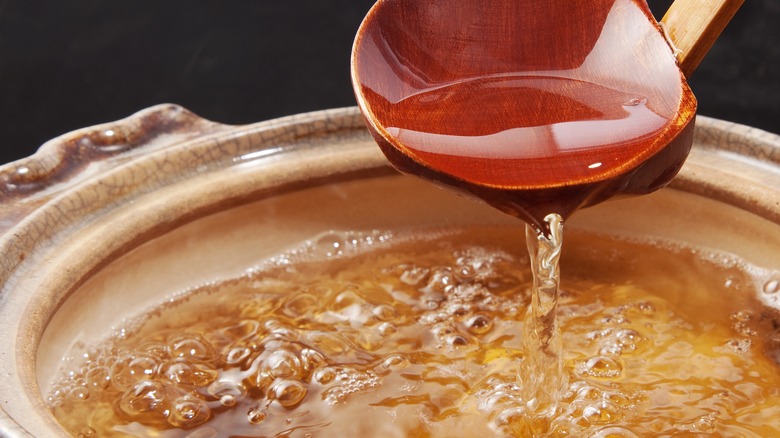Try David Chang's Method For Making Dashi
It's the broth essential to a range of North Asian dishes and provides the kick found in everything from soups to glazes and dipping sauces and even some sushi rice. Dashi is packed with glutamates, thanks to its umami-rich ingredients, which can include kelp or kombu, tuna flakes, shiitake mushrooms, and anchovy or sardine — and all of which give it a unique flavor. But celebrity chef David Chang bypasses his stovetop to make dashi. Instead, as he reveals via Instagram, he combines dried skipjack tuna or katsuobushi, dried Korean smoked anchovies, and dried seaweed or kombu, before adding water — and leaving it all to steep in his tea bottle.
The Momofuku chef is not unique in encouraging dashi makers to soak, instead of boil, dashi ingredients. But many Japanese and Korean cooks tend to steep ingredients as a first step before finishing the dashi broth in a pan over medium heat. Korean cooks also make their dashi by soaking its ingredients in room temperature water overnight, before heating it for around 90 minutes over low heat the next day.
David Chang's way of making dashi skips a step
Those of us who love our teas will understand Chang's preference for steeping his ingredients. The method entails allowing ingredients — whether it is tea leaves or dashi — to sit in hot water for long enough that we are left with either beverage (tea) or broth (dashi). And while we hardly associate the act of making tea with chemistry, steeping actually gives flavor molecules a chance to move around, traveling from an area where they are clustered to places where they have yet to be found. If you do decide to do things differently from Chang and simmer your dashi, it's important to ensure that the broth doesn't reach boiling point, which could leave you with a bitter-tasting liquid.
While Chang's method for making dashi may buck the norm, he doesn't stray from tradition in the way that he uses the broth. Like most Japanese and Korean cooks, he makes two batches, designed for two completely different purposes. He says: "First brew I use for soups. Second batch of dashi I use for braised things or spicy foods. After that, If you want add the contents to a container of soy sauce and let that sit in my fridge and use for dipping things or make a ponzu with some yuzu. Just don't boil everything. Steep it like a tea."

